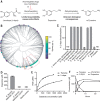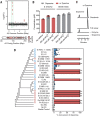Discovery and inhibition of an interspecies gut bacterial pathway for Levodopa metabolism
- PMID: 31196984
- PMCID: PMC7745125
- DOI: 10.1126/science.aau6323
Discovery and inhibition of an interspecies gut bacterial pathway for Levodopa metabolism
Abstract
The human gut microbiota metabolizes the Parkinson's disease medication Levodopa (l-dopa), potentially reducing drug availability and causing side effects. However, the organisms, genes, and enzymes responsible for this activity in patients and their susceptibility to inhibition by host-targeted drugs are unknown. Here, we describe an interspecies pathway for gut bacterial l-dopa metabolism. Conversion of l-dopa to dopamine by a pyridoxal phosphate-dependent tyrosine decarboxylase from Enterococcus faecalis is followed by transformation of dopamine to m-tyramine by a molybdenum-dependent dehydroxylase from Eggerthella lenta These enzymes predict drug metabolism in complex human gut microbiotas. Although a drug that targets host aromatic amino acid decarboxylase does not prevent gut microbial l-dopa decarboxylation, we identified a compound that inhibits this activity in Parkinson's patient microbiotas and increases l-dopa bioavailability in mice.
Copyright © 2019, American Association for the Advancement of Science.
Figures




Comment in
-
Gut microbes metabolize Parkinson's disease drug.Science. 2019 Jun 14;364(6445):1030-1031. doi: 10.1126/science.aax8937. Science. 2019. PMID: 31196998 No abstract available.
-
Drug Metabolism as a Community Effort.Cell Metab. 2019 Aug 6;30(2):235-237. doi: 10.1016/j.cmet.2019.07.005. Cell Metab. 2019. PMID: 31390549
-
The gut microbiota: A novel therapeutic target in Parkinson's disease?Parkinsonism Relat Disord. 2019 Sep;66:265-266. doi: 10.1016/j.parkreldis.2019.08.010. Epub 2019 Aug 12. Parkinsonism Relat Disord. 2019. PMID: 31445904 No abstract available.
References
Publication types
MeSH terms
Substances
Grants and funding
LinkOut - more resources
Full Text Sources
Other Literature Sources
Molecular Biology Databases

